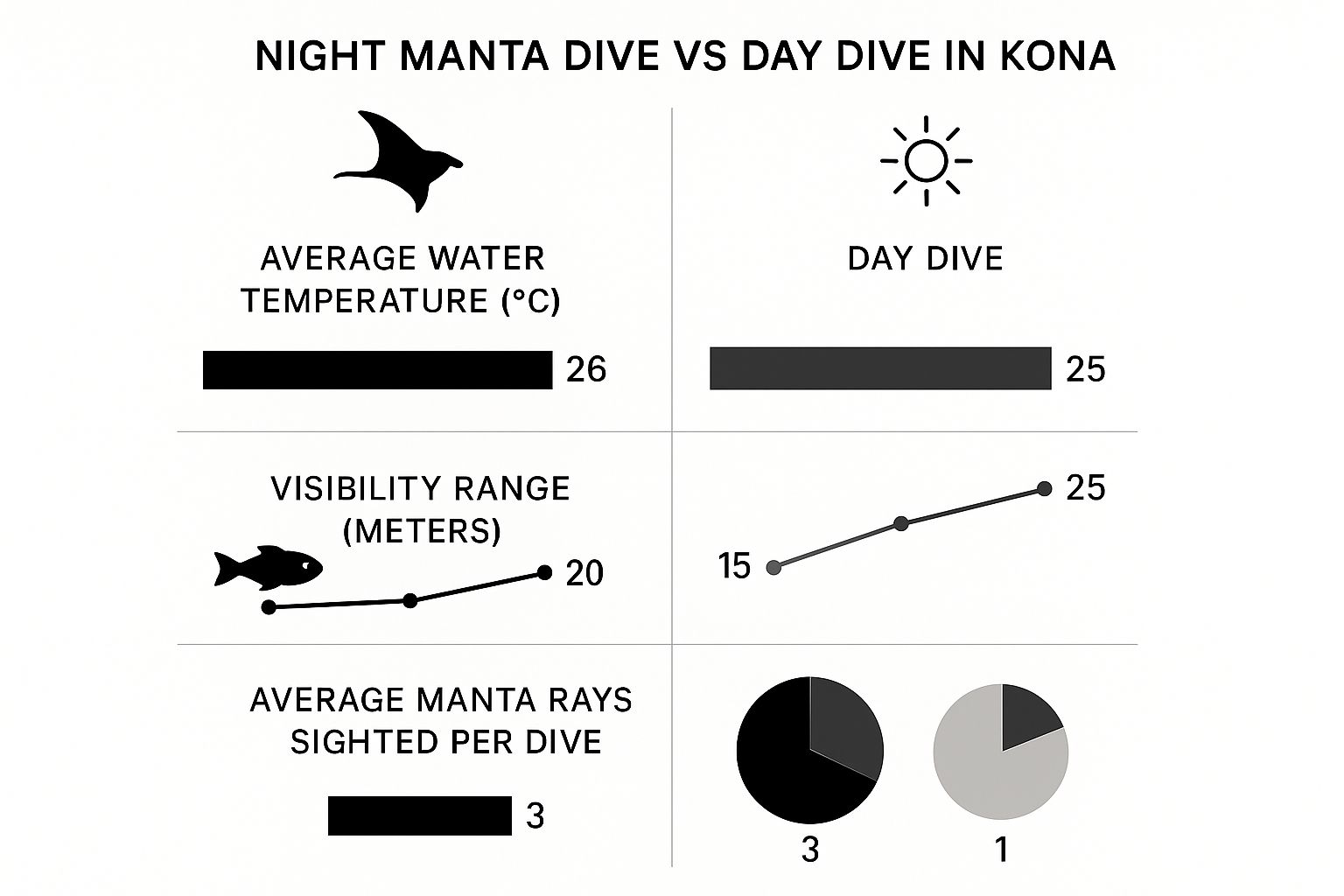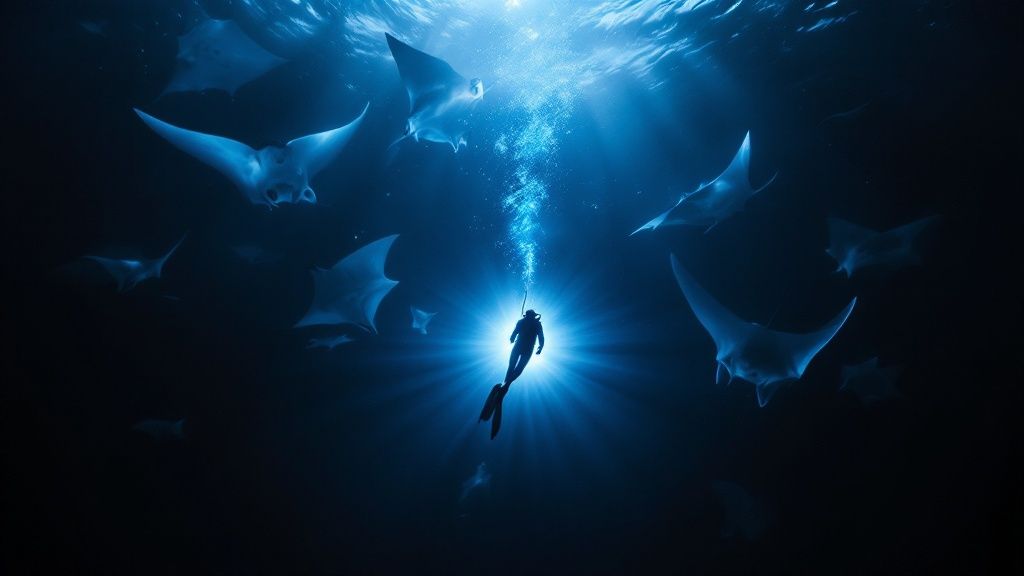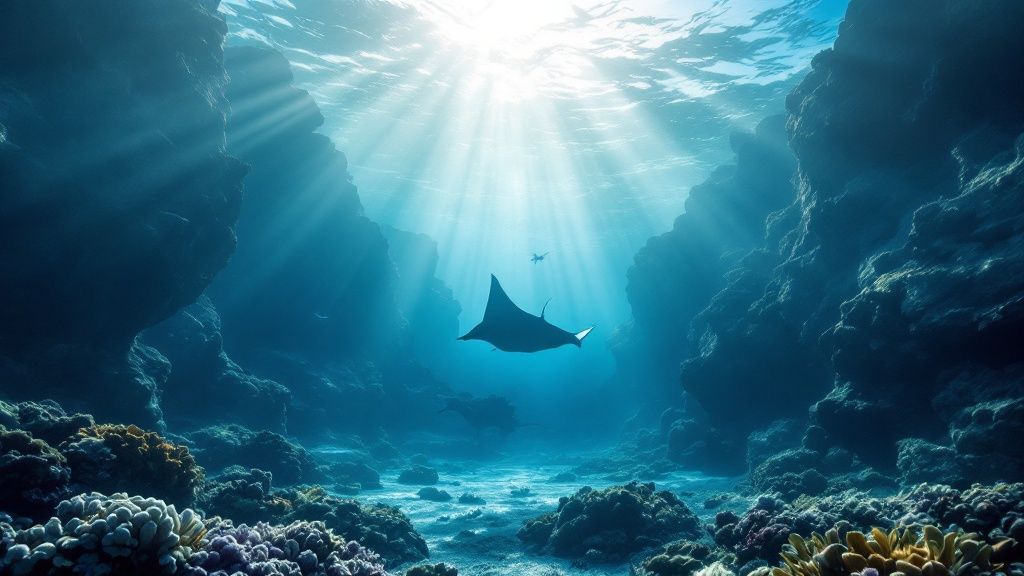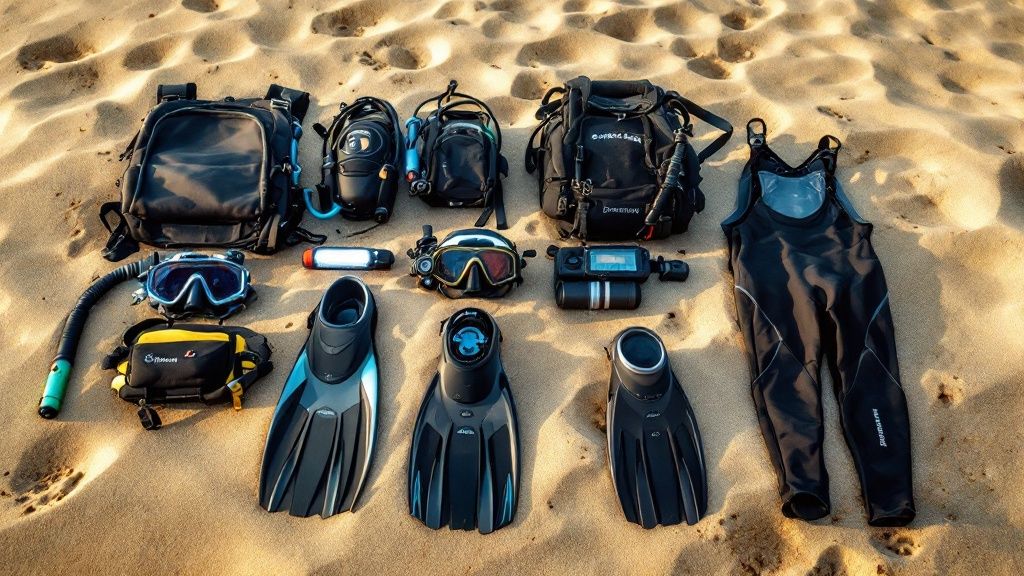Why Kona Has Become the Manta Ray Capital of the World
Kona, Hawaii, is more than just a stunning vacation spot; it's the place to encounter manta rays. What sets this location apart? It’s a special blend of environmental factors and responsible human interaction. These elements create an almost guaranteed chance to witness these gentle giants in their natural habitat.
The Perfect Feeding Grounds
Kona's underwater terrain is key. Volcanic activity created a seascape rich in nutrient-rich upwellings attracting tons of plankton, a manta ray's main food source. This bounty draws mantas to specific spots along the Kona coast. The shallow, sandy bottom at Manta Village, paired with excellent light penetration, makes the plankton glow. This underwater light show attracts both plankton and the mantas who feed on them. Further south, Manta Heaven, with its deeper waters and varied terrain, offers a different feeding ground, highlighting Kona's diverse underwater world.
Ideal Water Conditions and Accessibility
Kona's consistently warm, clear water creates the perfect environment for mantas and divers, allowing for year-round manta ray sightings. This consistency draws divers worldwide, hoping for a reliable, breathtaking experience. When diving in Kona, understanding the underwater environment is important, and this marine pollution article provides valuable insights. The infographic below offers a quick comparison of day and night dives:

Night dives offer warmer temperatures and a much higher probability of seeing multiple manta rays. The plankton are drawn to the dive lights, creating a feeding frenzy that attracts the mantas.
The Kona Coast boasts an 85-90% sighting success rate year-round for manta ray night dives. This, a thriving local manta population of over 450 individuals, and average sightings of three mantas per dive cement Kona's reputation. Learn more about manta ray statistics here.
To help illustrate the key differences between the two main dive sites, the following table summarizes the main features:
Kona Manta Dive Site Comparison
Compare the two primary manta ray dive locations in Kona
| Features | Manta Village | Manta Heaven |
|---|---|---|
| Depth | Shallow | Deeper |
| Terrain | Sandy bottom | Varied terrain |
| Plankton activity | High, especially at night | High |
| Manta Ray Sightings | Frequent | Frequent |
| Dive Type | Day and Night | Primarily Night |
As this table highlights, both sites offer exceptional manta ray viewing opportunities, each with its own unique characteristics.
The Magic of Night Diving
Daytime dives offer glimpses of these creatures, but night diving truly transforms the experience. Darkness amplifies the dive lights' effect, creating an ethereal glow around the feeding mantas. This unforgettable spectacle attracts divers globally. The combination of reliable sightings, perfect conditions, and the magic of night diving makes Kona the undisputed "Manta Ray Capital of the World".
Inside Your Manta Dive Kona: From Boat to Breathtaking

Your manta ray dive adventure in Kona starts well before you hit the water. The experience begins on the boat with a thorough pre-dive briefing. Experienced dive masters will walk you through the dive plan, highlighting safety procedures and responsible interaction with the manta rays. This important first step ensures a positive and safe encounter for both divers and the magnificent mantas.
Gearing Up for the Encounter
Next, it's time to prepare your dive equipment. Making sure everything works perfectly is essential. For manta ray dives, you might need specialized gear such as dive lights for better visibility in the dark and underwater cameras to capture the incredible experience. Knowing many divers want to document these encounters, numerous dive operators offer camera rentals and helpful advice on adjusting settings for low-light photography. They'll also explain how strategically positioned underwater lights attract plankton, creating a captivating "buffet" that draws the mantas closer.
The Descent into Magic
Once everyone is prepared, it's time to enter the water and begin your descent. Kona's manta ray dive sites are typically around 30 to 40 feet deep, making them accessible to divers of varying experience levels. The anticipation mounts as you descend, and then, the magic unfolds. Kona’s manta ray night dives offer awe-inspiring encounters that boost both local tourism and support ongoing scientific observation. Dive operators report an 85-90% manta sighting success rate. With dives lasting 45 to 60 minutes, you'll have ample opportunity to witness these gentle giants. For more detailed statistics, check out this Manta Ray Report. While you're marveling at these underwater wonders, you might also think about securing your own home. Learn more about enhancing your home security with a Crimsafe Sliding Door.
Observing the Gentle Giants
Attracted by the plankton illuminated by the dive lights, the manta rays perform a mesmerizing underwater ballet. They glide effortlessly through the water, often executing impressive barrel rolls just inches from amazed divers. It's a truly unforgettable spectacle, leaving even experienced divers in awe. Positioning yourself properly is important for respectful observation and getting the best possible view. Your dive master will guide you on how to observe without disrupting the mantas' natural feeding behavior.
Back on Board: Reflections and Memories
As your dive concludes and you ascend back to the boat, a sense of wonder and satisfaction will wash over you. The memory of these graceful giants and their captivating movements in the underwater light will remain long after you’re back on shore. This remarkable experience demonstrates why a manta ray dive in Kona deserves a spot on every diver's bucket list.
The Science Behind Kona's Magnificent Manta Ray Population

The magic of a manta ray dive in Kona, Hawaii isn't just about the incredible encounter; it's built upon a foundation of fascinating science. Researchers and dive operators work together to understand these gentle giants, constantly learning more about their behavior. A crucial element of this research focuses on the unique belly patterns of each manta ray. These patterns act like fingerprints, allowing scientists to identify and track individuals over decades. This detailed documentation helps build a comprehensive understanding of each manta's life.
Unraveling the Mysteries of Manta Behavior
Ongoing research, in partnership with marine biologists, is revealing the unique aspects of Kona's manta ray population. For example, studies have shown how their feeding habits have adapted to human presence and the plankton attracted by dive lights. This knowledge is essential for creating sustainable tourism practices that minimize disruption while still allowing for these up-close encounters.
Furthermore, continuous observation is illuminating the intricate social dynamics within the manta ray community. Scientists are gaining a deeper understanding of their interactions, communication methods, and social structures.
From 2009 through 2014, extensive research documented manta ray sightings along the Kona Coast, providing invaluable data on their population and behavior. Underwater videographers and marine researchers meticulously identified individual mantas, noted their physical condition, and tracked their locations at popular dive sites like Manta Village and Manta Heaven. This detailed approach has revealed key patterns in manta movement and sighting frequency, providing crucial insights for conservation.
To further illustrate the impact of this research, let's look at some key statistics. The table below provides a snapshot of the Kona manta ray population.
Kona Manta Ray Population Statistics
Key statistics about the manta ray population in Kona waters
| Statistic | Value | Significance |
|---|---|---|
| Identified Individuals | 450+ | Demonstrates a healthy and robust population |
| Average Wingspan | 12 feet | Indicates mature adults frequenting the area |
| Annual Sightings | Thousands | Highlights the consistent presence of mantas in Kona waters |
| Recapture Rate | High | Shows the effectiveness of identification and tracking methods |
These statistics underscore the importance of continued research and conservation efforts in preserving this remarkable population. For more detailed statistics, visit the Manta Ray Advocates website. You can also learn more about what a manta ray night dive entails from Kona Honu Divers.
Your Dive: A Contribution to Conservation
Each manta dive in Kona plays a part in ongoing conservation initiatives. Dive operators contribute significantly by sharing identification photos and behavioral observations with research teams. This collaborative approach ensures that data collected during dives directly informs scientific understanding and bolsters effective conservation strategies. This means your dive isn't just a personal adventure; it directly contributes to protecting these creatures for the future.
Sustainable Tourism: An Economic and Ecological Win-Win
The economic benefit of sustainable manta tourism is another vital component of the Kona manta dive experience. This approach showcases how responsible tourism can benefit local communities while safeguarding the marine environment. By prioritizing the well-being of the manta rays and their habitat, Kona helps ensure these animals will continue to thrive, drawing divers and supporting the local economy. This model serves as an example of how conservation and economic growth can work together.
Selecting Your Perfect Manta Dive Kona Operator
Not all manta dive Kona experiences are the same. Choosing the right operator can significantly impact your enjoyment and the well-being of the mantas. This means carefully considering several key factors before booking. You might be interested in: Why you should go on a manta ray dive in Kona.
Essential Questions To Ask
Asking the right questions upfront will reveal an operator’s dedication to safety and ethical practices. Consider these critical questions:
- What are their safety protocols? Inquire about emergency procedures, dive group sizes, and guide-to-diver ratios. Smaller groups often translate to more personalized attention.
- What is their experience level? Look for operators with a proven track record and extensive knowledge of the local waters and manta rays.
- What are their environmental practices? Do they adhere to responsible interaction guidelines? A commitment to sustainability demonstrates respect for the marine environment.
Evaluating Operator Practices
Beyond the initial questions, deeper investigation is crucial. Assess an operator based on these aspects:
- Environmental Commitment: Seek out operators actively involved in conservation efforts. Look for participation in manta ray identification programs or reef cleanup initiatives.
- Guide Expertise: A knowledgeable guide enhances your dive with insights into manta ray behavior and ensures respectful interactions.
- Group Sizes: Smaller groups offer a more personalized experience, minimizing disturbance to the mantas.
- Equipment Quality: Ensure the operator provides well-maintained equipment, including proper dive lights for night dives.
Understanding Pricing And Inclusions
Pricing varies between operators. It’s essential to understand what’s included:
- What’s Included: Does the price cover equipment rental, snacks, drinks, and transportation? Knowing upfront helps avoid surprises.
- Hidden Costs: Be cautious of unusually low prices, which might indicate compromised safety or quality.
- Value For Money: A higher price doesn't always mean a better experience. Balance cost against the operator’s reputation and offerings.
Considerations For Specific Divers
Different divers have unique needs. Consider these targeted tips:
- Photographers: Look for operators experienced with underwater photography. Guides should be knowledgeable about appropriate lighting and positioning for capturing the perfect shot ethically.
- First-Time Divers: Choose companies known for their patient and supportive approach to new divers. Clear communication and a reassuring guide can significantly improve the experience.
By carefully considering these points, you can select a manta dive Kona operator that provides an unforgettable experience while respecting these gentle giants and their environment.
Timing Your Manta Dive Kona For Maximum Encounters

While Kona offers amazing manta ray sightings all year, understanding the seasonal variations can truly enhance your diving experience. To optimize your manta dive Kona trip, consider factors such as moon phases, water clarity, and even how to avoid large crowds. For more detailed planning information, you might want to learn more about planning your Kona manta ray night dive.
The Moon's Influence: A Plankton Buffet
The moon phase plays a significant role in plankton density, which forms the core of the manta ray diet. A full moon often leads to increased plankton, attracting more mantas and intensifying their feeding activity. This creates a breathtaking spectacle as they elegantly navigate the illuminated waters, efficiently filtering plankton.
Seasonal Clarity: A Unique Perspective
Water clarity changes throughout the year, offering diverse viewing experiences. Winter months typically boast exceptional visibility, allowing for crystal-clear observations of these graceful creatures. While summer brings nutrient-rich waters, potentially attracting larger feeding groups, visibility might be slightly reduced. Each season provides its own captivating encounter.
Water Temperature and Sea Conditions: Comfort and Calm
Water temperature in Kona remains relatively stable and comfortable year-round. However, some divers might prefer a thin wetsuit during the winter months. Sea conditions tend to be calmer in the summer, providing a smoother boat ride. This can be a significant advantage for divers susceptible to seasickness.
Avoiding the Crowds: Strategic Planning
Smart planning can help you avoid crowded dives. Weekdays generally have fewer divers than weekends. Booking during the shoulder seasons (spring and fall) offers a more intimate experience without compromising sighting opportunities. This approach allows you to balance crowd size with optimal manta ray activity.
Maximizing Your Manta Ray Encounter: Key Takeaways
Here's a concise guide to help you strategically plan your manta dive Kona:
- Moon Phase: Schedule your dive around the full moon for potentially increased manta ray activity.
- Water Clarity: Winter offers the best visibility, while summer may bring larger feeding groups.
- Sea Conditions: Summer typically offers calmer waters.
- Crowd Levels: Opt for mid-week dives and consider the shoulder seasons for a less crowded experience.
By considering these factors, you can elevate your manta ray diving experience from amazing to truly unforgettable. Whether you're planning well in advance or looking for a last-minute dive, understanding these seasonal and environmental influences will significantly increase your chances of witnessing the magic of manta rays in Kona.
Preparing For Your First Magical Manta Dive Kona
Preparing for your first manta ray dive in Kona is thrilling! It's a mix of excitement and practical planning to ensure a safe and unforgettable experience. From understanding certification requirements to respecting the mantas, a little preparation goes a long way.
Certification and Experience Levels
Many people ask, "Do I need to be a certified diver?" While certification unlocks more opportunities, snorkeling trips cater to non-certified participants. These surface trips provide a unique view of the mantas' graceful movements from above. However, certified divers witness the magic from the ocean floor, gazing upward as the mantas glide overhead. This perspective creates a truly immersive and unforgettable encounter.
Essential Equipment For Manta Night Dives
Night diving requires specific gear. A reliable dive light is essential, both for your visibility and to attract plankton, the mantas' primary food source. Dive operators usually provide lights, but a backup is always recommended. An underwater camera allows you to capture these magical moments. Learn more in our article about what you should know about a manta ray dive in Kona.
Pre-Dive Practices For a Smooth Experience
Before entering the water, familiarize yourself with the dive site and safety procedures. Many operators conduct pre-dive briefings covering these important details. This is especially crucial for night dives, as the darkness adds an additional challenge. Practicing fundamental dive skills like buoyancy control and mask clearing increases confidence and allows you to fully appreciate the manta rays.
Adapting To Kona's Waters and Dive Etiquette
Kona's waters are typically calm and warm. However, new divers should consider any pre-existing medical conditions and consult a doctor if needed. Once in the water, remember manta ray etiquette: never touch or pursue the mantas. Maintain a respectful distance and observe their natural behavior without interference. This ensures a safe and positive experience for both you and the majestic creatures.
Physical Preparation and Respectful Observation
While diving isn't an extreme sport, moderate physical fitness enhances enjoyment. Simple exercises like swimming and light cardio improve stamina and comfort in the water. Remember, you are a visitor in the mantas' home. Respectful observation is paramount. Avoid sudden movements or loud noises, letting the mantas approach you on their terms. This creates a truly magical and ethical experience.
Beyond the Manta Dive: Kona's Complete Underwater World
While the manta ray night dive is an incredible experience, Kona has so much more to offer beneath the waves. The island's volcanic history has sculpted a unique underwater landscape, unlike anywhere else in Hawaii. From dramatic lava tubes to vibrant coral reefs, there's a whole other world waiting to be explored. Extending your diving adventure beyond the manta rays allows you to truly experience the full spectrum of Kona’s marine ecosystem.
Exploring Kona's Diverse Underwater Terrain
Kona's volcanic past has shaped its underwater world in remarkable ways. Ancient lava flows have created a network of lava tubes and caverns, offering exciting swim-throughs for more experienced divers. These formations provide a thrilling contrast to the open-ocean manta ray dives. Along the coastline, vibrant coral reefs teem with a dazzling array of colorful fish and invertebrates.
Encounters with Endemic Hawaiian Species
Kona’s reefs are home to an impressive variety of marine life, with many species found nowhere else on Earth. These endemic Hawaiian species add a special element of wonder to every dive. You might encounter the brightly colored Hawaiian reef triggerfish, or the elusive banded coral shrimp. Observing these unique creatures in their natural habitat offers a deeper appreciation for Kona's rich biodiversity. For more information, check out: Dive the Big Island of Hawaii with Kona Honu Divers.
Seasonal Wonders: Whales, Dolphins, and Turtles
Kona's waters are also frequented by a range of migratory and resident marine animals. During winter, humpback whales migrate to Hawaiian waters to breed and give birth, providing incredible whale watching opportunities. Throughout the year, resident dolphin pods are often seen playing in the waves. Sea turtle cleaning stations offer fascinating insights into the symbiotic relationships within the reef.
Crafting a Multi-Day Kona Diving Itinerary
To fully experience Kona's diverse underwater environment, consider a multi-day itinerary. This allows you to balance the magic of the manta ray night dives with daytime explorations of reefs, lava tubes, and other dive sites. Combining these experiences will give you a comprehensive understanding of Kona’s extraordinary marine environment and maximize your Hawaiian diving adventure.
Dive into the heart of Kona's underwater magic with Kona Honu Divers. We offer a range of dive trips and experiences for all skill levels, from beginner to advanced. Explore our website and book your unforgettable Kona diving adventure today!
